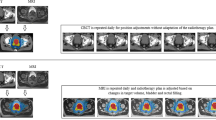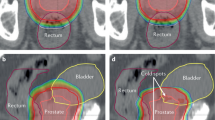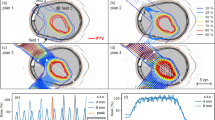Abstract
Proton radiation is an emerging therapy for localized prostate cancer that is being sought with increasing frequency by patients. The physical properties of a proton beam make it ideal for clinical applications; the Bragg peak allows for deposition of dose at a well-defined depth with essentially no exit dose. Thus, high doses can be delivered to a target while largely sparing adjacent normal tissue. Proton radiation has proven effective in dose escalation for prostate cancer. This is important, as high-dose conformal radiation is now the standard form of external radiation for this disease. Intensity-modulated radiation therapy, which uses X-rays, is another means of delivering high radiation doses to the prostate and is currently the most widely used form of external radiation in the US. At present prices, it is probably more cost-effective than proton radiation; this could change. Clear dosimetric superiority of protons in the high-dose region has not yet been demonstrated. A dosimetric advantage may emerge as pencil-beam scanning replaces passive scanning, and intensity-modulated proton therapy becomes possible. This technique would be particularly well suited to partial prostate 'boosts', hypofractionation regimens and stereotactic delivery of radiation, all new approaches to prostate cancer that are being investigated.
Key Points
-
Proton beams deposit a large proportion of radiation dose within a short range, minimizing exposure of nontarget tissue
-
The earliest available means of dose escalation, proton radiation is now more costly than brachytherapy and intensity-modulated radiation therapy (IMRT)
-
The deep-pelvic location of the prostate, gland motion, and relatively large penumbra of proton beams at depth limit the potential of proton radiation in its current form
-
Technological advances are likely to increase the clinical utility of proton beam therapy, particularly in relation to hypofractionation, partial prostate boosting and in vivo dosimetry
This is a preview of subscription content, access via your institution
Access options
Subscribe to this journal
Receive 12 print issues and online access
$209.00 per year
only $17.42 per issue
Buy this article
- Purchase on Springer Link
- Instant access to full article PDF
Prices may be subject to local taxes which are calculated during checkout


Similar content being viewed by others
References
Khan, F. M. The Physics of Radiation Therapy 2nd edn (Lippincott Williams & Wilkins, Philadelphia, 1984).
Gunderson, L. L. & Tepper, J. E. (Eds) Clinical Radiation Oncology 2nd edn (Elsevier Churchill Livingstone, Amsterdam, 2007).
Crook, J. et al. Postradiotherapy prostate biopsies: what do they really mean? Results for 498 patients. Int. J. Radiat. Oncol. Biol. Phys. 48, 355–367 (2000).
Crook, J. M., Perry, G. A., Robertson, S. & Esche, B. A. Routine prostate biopsies following radiotherapy for prostate cancer: results for 226 patients. Urology 45, 624–631 (1995).
Kuban, D. A., el-Mahdi, A. M. & Schellhammer, P. F. Effect of local tumor control on distant metastasis and survival in prostatic adenocarcinoma. Urology 30, 420–426 (1987).
Fuks, Z. et al. The effect of local control on metastatic dissemination in carcinoma of the prostate: long-term results in patients treated with 125I implantation. Int. J. Radiat. Oncol. Biol. Phys. 21, 537–547 (1991).
Zagars, G. K., von Eschenbach, A. C., Ayala, A. G., Schultheiss, T. E. & Sherman, N. E. The influence of local control on metastatic dissemination of prostate cancer treated by external beam megavoltage radiation therapy. Cancer 68, 2370–2377 (1991).
Coen, J. J., Zietman, A. L., Thakral, H. & Shipley, W. U. Radical radiation for localized prostate cancer: local persistence of disease results in a late wave of metastases. J. Clin. Oncol. 20, 3199–3205 (2002).
Shipley, W. U. et al. Advanced prostate cancer: the results of a randomized comparative trial of high dose irradiation boosting with conformal protons compared with conventional dose irradiation using photons alone. Int. J. Radiat. Oncol. Biol. Phys. 32, 3–12 (1995).
Zelefsky, M. J. et al. Dose escalation with three-dimensional conformal radiation therapy affects the outcome in prostate cancer. Int. J. Radiat. Oncol. Biol. Phys. 41, 491–500 (1998).
Kuban, D. A. et al. Long-term results of the MD Anderson randomized dose-escalation trial for prostate cancer. Int. J. Radiat. Oncol. Biol. Phys. 70, 67–74 (2008).
Peeters, S. T. et al. Dose-response in radiotherapy for localized prostate cancer: results of the Dutch multicenter randomized phase III trial comparing 68 Gy of radiotherapy with 78 Gy. J. Clin. Oncol. 24, 1990–1996 (2006).
Sathya, J. R. et al. Randomized trial comparing iridium implant plus external-beam radiation therapy with external-beam radiation therapy alone in node-negative locally advanced cancer of the prostate. J. Clin. Oncol. 23, 1192–1199 (2005).
Zietman, A. L. et al. Comparison of conventional-dose vs high-dose conformal radiation therapy in clinically localized adenocarcinoma of the prostate: a randomized controlled trial. JAMA 294, 1233–1239 (2005).
Dearnaley, D. P. et al. Escalated-dose versus standard-dose conformal radiotherapy in prostate cancer: first results from the MRC RT01 randomised controlled trial. Lancet Oncol. 8, 475–487 (2007).
Dearnaley, D. P. et al. Comparison of radiation side-effects of conformal and conventional radiotherapy in prostate cancer: a randomised trial. Lancet 353, 267–272 (1999).
Ryu, J. K. et al. Interim report of toxicity from 3D conformal radiation therapy (3D-CRT) for prostate cancer on 3DOG/RTOG 9406, level III (79.2 Gy). Int. J. Radiat. Oncol. Biol. Phys. 54, 1036–1046 (2002).
Zelefsky, M. J. et al. High dose radiation delivered by intensity modulated conformal radiotherapy improves the outcome of localized prostate cancer. J. Urol. 166, 876–881 (2001).
Zietman, A. L. et al. A prospective phase I/II study using proton beam radiation to deliver 82 GyE to men with localized prostate cancer: preliminary results of ACR 0312. Int. J. Radiat. Oncol. Biol. Phys. 72 (Suppl.), S77 (2008).
Huang, E. H. et al. Late rectal toxicity: dose–volume effects of conformal radiotherapy for prostate cancer. Int. J. Radiat. Oncol. Biol. Phys. 54, 1314–1321 (2002).
Cheung, M. R. et al. Investigation of bladder dose and volume factors influencing late urinary toxicity after external beam radiotherapy for prostate cancer. Int. J. Radiat. Oncol. Biol. Phys. 67, 1059–1065 (2007).
Lomax, A. J., Pedroni, E., Rutz, H. & Goitein, G. The clinical potential of intensity modulated proton therapy. Z. Med. Phys. 14, 147–152 (2004).
Trofimov, A. et al. Radiotherapy treatment of early-stage prostate cancer with IMRT and protons: a treatment planning comparison. Int. J. Radiat. Oncol. Biol. Phys. 69, 444–453 (2007).
Hall, E. J. & Wuu, C. S. Radiation-induced second cancers: the impact of 3D-CRT and IMRT. Int. J. Radiat. Oncol. Biol. Phys. 56, 83–88 (2003).
Miralbell, R., Lomax, A., Cella, L. & Schneider, U. Potential reduction of the incidence of radiation-induced second cancers by using proton beams in the treatment of pediatric tumors. Int. J. Radiat. Oncol. Biol. Phys. 54, 824–829 (2002).
Hall, E. J. Intensity-modulated radiation therapy, protons, and the risk of second cancers. Int. J. Radiat. Oncol. Biol. Phys. 65, 1–7 (2006).
Paganetti, H., Bortfeld, T. & Delaney, T. F. Neutron dose in proton radiation therapy: in regard to Eric J. Hall (Int J Radiat Oncol Biol Phys 2006; 65, 1–7). Int. J. Radiat. Oncol. Biol. Phys. 66, 1594–1595 (2006).
Mesoloras, G., Sandison, G. A., Stewart, R. D., Farr, J. B. & Hsi, W. C. Neutron scattered dose equivalent to a fetus from proton radiotherapy of the mother. Med. Phys. 33, 2479–2490 (2006).
Wroe, A., Rosenfeld, A. & Schulte, R. Out-of-field dose equivalents delivered by proton therapy of prostate cancer. Med. Phys. 34, 3449–3456 (2007).
Liauw, S. L., Sylvester, J. E., Morris, C. G., Blasko, J. C. & Grimm, P. D. Second malignancies after prostate brachytherapy: incidence of bladder and colorectal cancers in patients with 15 years of potential follow-up. Int. J. Radiat. Oncol. Biol. Phys. 66, 669–673 (2006).
Kendal, W. S., Eapen, L., Macrae, R., Malone, S. & Nicholas, G. Prostatic irradiation is not associated with any measurable increase in the risk of subsequent rectal cancer. Int. J. Radiat. Oncol. Biol. Phys. 65, 661–668 (2006).
Konski, A., Speier, W., Hanlon, A., Beck, J. R. & Pollack, A. Is proton beam therapy cost effective in the treatment of adenocarcinoma of the prostate? J. Clin. Oncol. 25, 3603–3608 (2007).
Brenner, D. J. & Hall, E. J. Fractionation and protraction for radiotherapy of prostate carcinoma. Int. J. Radiat. Oncol. Biol. Phys. 43, 1095–1101 (1999).
Fowler, J., Chappell, R. & Ritter, M. Is alpha/beta for prostate tumors really low? Int. J. Radiat. Oncol. Biol. Phys. 50, 1021–1031 (2001).
Yeoh, E. E. et al. Hypofractionated versus conventionally fractionated radiation therapy for prostate carcinoma: updated results of a phase III randomized trial. Int. J. Radiat. Oncol. Biol. Phys. 66, 1072–1083 (2006).
Lukka, H. et al. Randomized trial comparing two fractionation schedules for patients with localized prostate cancer. J. Clin. Oncol. 23, 6132–6138 (2005).
Madsen, B. L. et al. Stereotactic hypofractionated accurate radiotherapy of the prostate (SHARP), 33.5 Gy in five fractions for localized disease: first clinical trial results. Int. J. Radiat. Oncol. Biol. Phys. 67, 1099–1105 (2007).
Mouraviev, V. et al. Prostate cancer laterality does not predict prostate-specific antigen recurrence after radical prostatectomy. Urology 70, 1141–1145 (2007).
Rajesh, A., Coakley, F. V. & Kurhanewicz, J. 3D MR spectroscopic imaging in the evaluation of prostate cancer. Clin. Radiol. 62, 921–929 (2007).
Nederveen, A. J., van der Heide, U. A., Hofman, P., Welleweerd, H. & Lagendijk, J. J. Partial boosting of prostate tumours. Radiother. Oncol. 61, 117–126 (2001).
Pickett, B., Vigneault, E., Kurhanewicz, J., Verhey, L. & Roach, M. Static field intensity modulation to treat a dominant intra-prostatic lesion to 90 Gy compared to seven field 3-dimensional radiotherapy. Int. J. Radiat. Oncol. Biol. Phys. 44, 921–929 (1999).
Bos, L. J. et al. Reduction of rectal dose by integration of the boost in the large-field treatment plan for prostate irradiation. Int. J. Radiat. Oncol. Biol. Phys. 52, 254–265 (2002).
Parodi, K. et al. Patient study of in vivo verification of beam delivery and range, using positron emission tomography and computed tomography imaging after proton therapy. Int. J. Radiat. Oncol. Biol. Phys. 68, 920–934 (2007).
Author information
Authors and Affiliations
Corresponding author
Ethics declarations
Competing interests
The authors declare no competing financial interests.
Rights and permissions
About this article
Cite this article
Coen, J., Zietman, A. Proton radiation for localized prostate cancer. Nat Rev Urol 6, 324–330 (2009). https://doi.org/10.1038/nrurol.2009.83
Published:
Issue Date:
DOI: https://doi.org/10.1038/nrurol.2009.83



